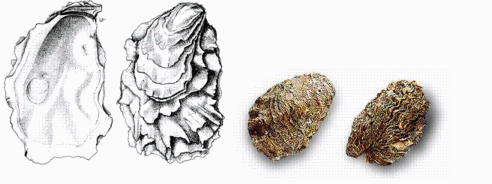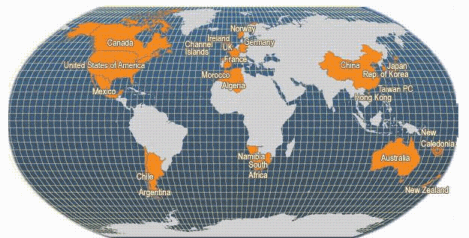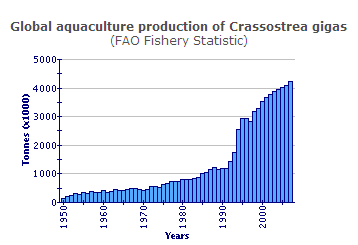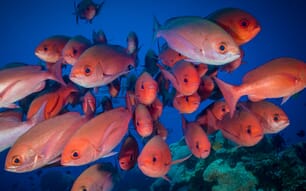Identity
Crassostrea gigas Thunberg, 1793 [Ostreidae]
FAO Names: En - Pacific cupped oyster, Fr - Huître creuse du Pacifique, Es - Ostión japonés

Biological features
Shell solid, inequivalve, extremely rough, extensively fluted, and laminated; left (lower) valve deeply cupped, its sides sometimes almost vertical, the right (upper) valve flat or slightly convex sitting withing left; inequilateral, beaks and umbones often overgrown; tending to be oblong in outline but often disorted and very irregular. The shape of the shell varies with the environment. Colour usually whitish with many purple streaks and spots radiating away from the umbo. The interior of the shell is white, with a single muscle scar that is sometimes dark, but never purple or black.
View SIDP Species fact sheet
Profile
Historical background
Through its potential for rapid growth and its wide ranging tolerance to environmental conditions, the Pacific cupped oyster has become the oyster of choice for cultivation in many regions of the world. While its origins are in Japan, where it has been cultivated for centuries, it has been the subject of widespread introductions elsewhere, most significantly to the western seaboard of the United States of America from the 1920s and to France beginning in 1966. The Pacific oyster has been introduced either to replace stocks of indigenous oysters severely depleted by over-fishing or disease, or to create an industry where none existed before. The introductions list is likely to be incomplete and may not include accidental introductions made through global shipping activity, i.e. larvae carried in ballast water or adults attached to the hulls of ships. There have also been extensive, small-scale, undocumented secondary introductions from country to country. Historic methods of extensive culture, supported by wild seed capture and relaying in productive areas, have evolved over time to include a wide range of suspended (hanging culture) and off-bottom methodologies utilizing both wild and hatchery cultivated seed. Recent developments include the production of triploid seed in hatcheries and selection programmes that focus on producing faster growing, higher quality seed stock suited to particular conditions.

Besides the countries shown in the map above, introductions have been recorded also in:
- Ecuador, Belize, Costa Rica, Puerto Rico, the United States Virgin Islands, and Brazil.
- Israel, Philippines, and Malaysia.
- Romania and the Ukraine.
- Seychelles.
- Fiji, French Polynesia, Guam, Palau, Samoa, and Vanuatu.
Habitat and biology
The Pacific cupped oyster is an estuarine species, preferring firm bottom substrates where it leads a sedentary existence attached to rocks, debris and shells from the lower intertidal zone to depths of 40 m. However, these oysters can also be found on mud and sand-mud bottoms. Optimal salinity range is between 20 and 25 per cent although the species can occur at salinities below 10 per cent and will survive salinities in excess of 35 per cent, where it is unlikely to breed. It also has a broad temperature tolerance, with a range of –1.8 to 35 °C.
Pacific oysters are protandrous hermaphrodites, most commonly maturing first as males. In areas with good food supply the sex ratio in older oysters shows a predominance of females, whereas the reverse is true in areas of low food supply. Females can revert back to male when food supply is limiting as, for example, when they are severely overcrowded. Gametogenesis begins at around 10 °C at salinities of between 15 and 32 per cent and is rarely completed at higher salinities. Spawning generally occurs at temperatures above 20 °C and rarely at 15–18 °C. The species is very fecund with 8–15 cm length females producing between 50–200 million eggs in a single spawning.
Larvae are planktotrophic and are distributed throughout the water column. They measure 70 µm shell length at the prodissoconch I stage – following early embryonic development – and settle out of the water column to crawl, using the larval foot, to seek a suitable settlement location for attachment when 300–340 µm. This may take two to three weeks, depending on water temperature, salinity and food supply, during which time they can be dispersed over a wide area by water currents. As in other oyster species, mature Pacific cupped oyster larvae attach permanently to the chosen substrate by a cement secretion from a gland in the foot. Once settled they metamorphose into the juvenile form. Growth rate is very rapid in good conditions; market size being attained in 18 to 30 months.
Production

Production systems
Various methodologies are used in the production of Pacific cupped oysters, relating to the source of seed supply, the environmental conditions pertaining in different regions and the type of product marketed, whether oysters for the half-shell trade or for meat extraction. Differences in approach are highlighted below with emphasis on seed supply from hatcheries.
Seed supply
Where a supply of natural spat is abundant and reliable, oyster growers set out collectors in the wild to secure their own seed supply, independent of hatcheries. Much of the global supply of spat is obtained from wild seed capture, using a wide variety of settlement materials (cultch) hanging in suspension from longlines and rafts. However, other commercial units operate hatcheries, as described below.
Broodstock
Broodstock for hatchery use is usually obtained from a commercial unit's own sea-based growout facility and is from selected stock maintained in the best possible conditions. Since the sex of adults is not known, groups of adults are obtained at regular intervals from winter through to the natural spawning season. They are held in separate flow-through tanks supplied with cultured algae supplemented seawater at 20–22 °C and salinity within the range 25–32 per cent. During the winter months, when adults are sexually undeveloped, about six weeks of hatchery conditioning is required to initiate gametogenesis and mature the gametes. A progressively shorter period applies as ambient sea temperature increases towards the spawning season.
Adults containing ripe gametes can be spawned by thermal shock treatment but most commonly they are opened and the gametes 'stripped' from the gonads with Pasteur pipettes, a procedure that produces good results. Ripe females of 70–100 g live weight will yield in excess of 50–80 million eggs. For production purposes, the eggs of six or more females are fertilised with small samples of sperm from a similar number of males. Development from the fertilised egg to the fully shelled prodissoconch I (D-larva) stage takes place in large volume tanks filled with finely filtered – and often UV-treated – seawater at 25–28 °C and 25–32 per cent. Tanks are not aerated and no food is added during early development, which takes approximately 24 hours. Much of global hatchery output now focuses on the production of triploids. Ploidy manipulation, generally by temperature shock, takes place shortly after fertilisation although the most recent trend is to cross tetraploids with diploids, which guarantees 100 per cent triploid offspring.
Larval and post-larval culture
Larvae are grown in either static water or flow-through tank systems through to the pelagic veliger stage, which lasts 14 to 18 days at 25–28 °C. Optimum salinity is between 20 and 25 per cent. Initial density is about 20 000 D-larvae/litre and is reduced to about 5 000/litre as development proceeds through natural mortality and selective grading at water changes, which take place three or four times a week for static water tank systems. The object is to retain only the faster growing, healthier larvae as settlement and metamorphosis approaches.
Larvae are fed cultured algae. Early stage veligers (<120 µm shell length) are supplied with daily rations of Isochrysis galbana or Pavlova lutherii, together with a small diatom such as Chaetoceros calcitrans or Thalassiosira pseudonana. The diet of later stage larvae consists of the same species, supplemented with one or other of the various species of the larger green flagellate, Tetraselmis. When larvae are close to settlement, darkly pigmented 'eye-spots' develop, which are clearly visible through the transparent shell valves. A foot also develops at this stage. At this time, settlement substrate is placed in the tanks for the larvae to explore and attach to. Materials such as slightly roughened, black PVC sheets, fluted PVC pipes, shells or shell particles are used as settlement surfaces. Alternatively, mature larvae may be packed and shipped to oyster growers to set themselves and grow to market size at sites often at great distance from the hatchery. The latter is the method of choice on the Pacific coast of North America and the process is referred to as remote setting.
In many other parts of the world, hatcheries set and grow the resulting juveniles (spat) to a few millimetres (between 3–5 mm) in closely controlled conditions within the hatchery facility. This phase of production is usually accomplished in large volume tank systems with partial daily water replacement, in which the juveniles are held as fluidised beds in containers in a process referred to as upwelling culture. Rations of high nutritional value algae from hatchery culture or from algae bloomed in adjacent outdoor tanks or ponds are supplied continuously to promote rapid growth. Once grown to the required size the spat are either transferred to the hatchery's own outdoor nursery systems or are packed and sold to oyster growers.
Nursery
Hatcheries frequently operate either sea-based or land-based nurseries in which spat are grown from as small as 1 mm length to 12–15 mm. Densities may be as high as 100 kg/m³ water flow in highly productive areas. This method is adopted to reduce mortality in small spat, which may occur if they are transferred directly to sea-based grow-out. Sea-based nurseries are generally upwelling systems mounted on barges or rafts and are located in warmer, more productive estuarine environments. Such containment minimises risk of losses through predation. Upwelling methodology is also widely used in land-based nurseries, which may be mounted on barges in salt water ponds or in on-land tank systems supplied with algae-rich water pumped from ponds. The ponds may be naturally productive or be enriched with artificial or natural fertilisers. In the case of remote setting, where spat are set on bagged shell cultch, shell strings or plastic materials, the tanks used to set the larvae are also used to grow the resulting spat for a few days or more. This is prior to the set cultch being deployed in some form of protective culture (either intertidally with mesh or canvas covers or sub-tidally on racks or in suspension) to minimise predation losses. Wild caught spat is handled in a similar way.
Yields of 10–15 mm seed for grow-out can reach 3 tonnes/ha in upwelling nurseries supplied from fertilised ponds.
Ongrowing techniques
Grow-out is almost entirely sea-based. A variety of bottom, off-bottom and suspended culture methods are used, depending on the environment (e.g. tidal range, shelter, water depth on leases, water exchange rates in bays and estuarine inlets, the nature of substrates, etc.) and tradition.
Growth is rapid between 15–25 °C and at salinities between 25 and 32 per cent. It is dependent on the rate of replenishment of the natural phytoplankton food supply. Pacific cupped oysters will take from 18-30 months to reach a market size of 70–100 g live weight (shell-on). Yields from extensive lease areas (covering thousands of hectares), which are used for all aspects of grow-out, including seed collection, the nursery and growing phases, and for hardening oysters prior to harvest, can yield 25 tonnes/ha/yr. Much greater yields (>70 tonnes/ha/yr) can be obtained from well spatially separated, small area leases.
Bottom culture
Seed can be sown on suitably firm intertidal or sub-tidal ground, which may be hardened by the pre-application of shell or gravel, at densities of 200–400/m² when 1 to 2 g live weight, with predator-proof protection (fences or net covers). Alternatively, they can be sown without protection at ~200/m² when 10 g live weight. The object is to sow at densities that will require no further husbandry until the oysters reach marketable size.
Off-bottom culture
Seed are contained in mesh bags or perforated plastic trays of various types attached by rope or rubber bands to wood frame or rebar steel trestles on suitable ground in the low intertidal zone. Such systems are sometimes located sub-tidally but this adds to handling costs. Off-bottom culture may be used for the intermediate nursery phase of growth or as a method to grow product to market size. 10–15 mm seed can be stocked at 1 000–2 000 per 0.25 or 0.5 m² base area trays and need regular maintenance and servicing to transfer at lower density to clean bags/trays of increasing mesh size as they grow. Growth rate slows substantially once the biomass of oysters exceeds 5 kg/m² tray area in reasonably productive areas.
Suspended culture
Three-dimensional containment units are used in hanging culture, which is from longlines (most commonly) or from rafts. The units can be strings or wires of shells to which spat have attached, or they can be series of nets, mesh bags or plastic trays strung together and suspended vertically from the horizontal lines or rafts. This form of culture is used in deeper waters and the same stock densities per net or tray apply as for off-bottom methods. Care needs to be taken to sink units to water depths where fouling organisms are less prevalent and to avoid them touching the bottom at low water. Regular maintenance and servicing is required, to transfer growing oysters at lower density to clean nets/trays of increasing mesh size as they grow.
Floating Culture
Wood frame trays with mesh bases or perforated plastic trays provided with buoyancy collars (styrofoam) are used in some locations for earlier stages in the growth of seed. The tops of such units need to be covered with a canvas or tightly woven mesh to exclude light.
Hardening
Pacific oysters grown in suspended culture are commonly 'hardened' for a period of up to three or four months prior to harvesting. The process of hardening allows daily periods of exposure to air and generally takes place in the intertidal zone or in shallow water where tidal range is sufficient. Aerially exposed oysters have higher meat content and better keeping qualities once harvested.
Harvesting techniques
Oysters are usually harvested at >75 mm shell length when 70–100+ g live weight. Harvesting from bottom culture is by hand raking and picking or by dredges when intertidal beds are submerged, or by dredging sub-tidal beds. Marketable oysters grown in off-bottom rack culture or in trays or nets suspended from longlines are harvested from small boats or self-propelled barges, which are often equipped with mechanical washing and grading machinery when the product is destined for the half shell trade. When grown in areas where Paralytic Shellfish Poison (PSP), Diarrhoeic Shellfish Poison (DSP) and other neurotoxins from harmful algal blooms may be present at certain times of the year, harvesting may be halted during such occurrences. Oysters are not usually harvested for a period of two or three months following spawning, for reasons of poor meat quality.
Handling and processing
Smaller individuals may be sold as speciality 'cocktail' oysters. They are either sold live in shell or are shucked and processed frozen, smoked and canned in oil, dried, extracted for oyster sauce, or prepared as other value-added products.
Oysters grown in faecal coliform-free waters require minimal processing. They are washed and graded for size and shape and, if from bottom culture, may be held in tanks in a flow of seawater to rid themselves of sand and mud trapped in the mantle cavity. If faecal coliform contaminated, oysters will require a period of depuration in recirculation systems equipped for UV-light or ozone sterilisation. Single oysters destined for half shell markets are packed with the cupped valve down in order to conserve mantle cavity water. Shelf life is seven to ten days when properly packed and stored in cool conditions. Vacuum packed, value-added products in the half shell have been marketed in Europe with some success, although the bulk of trade is for the live product. In many other countries harvested oysters are transported to shucking plants for meat extraction, bottling, canning or freezing, or are used in the preparation of products such as oyster sauces. Processing is strictly controlled in most countries.
Production costs
Information on production costs is difficult to obtain, not only because the information is proprietary but also because of site specific factors, the diversity of methods used and the widely varying levels of technology employed. Seed supply is generally calculated to be in the vicinity of 20–25 per cent of total costs. In developed countries, 3–4 mm hatchery-produced seed is sold at US$10–15/1 000, while mature larvae for remote setting will cost approximately US$2million (ex transport costs). Culturing oysters for the shucked meat trade is less labour and equipment intensive than producing oysters for half shell markets, and bottom culture is less costly than suspended (hanging) culture. Feed does not figure in the cost equation because it is a free resource once seed is transferred to sea-based grow-out. Labour is a major recurring cost and is generally of a seasonal nature.
Diseases and control measures
In contrast to other oysters of importance in commerce, and despite its widespread distribution around the world, few disease problems of major significance have been reported for the Pacific cupped oyster. Of greater concern have been incidences of 'summer mortality' on the Pacific coast of the US and in France, which appears to be related to post-spawning physiological stress in warm water when oysters are densely crowded. Introductions of Pacific oysters are not thought to have brought pathogens with them that have resulted in catastrophic diseases in indigenous bivalves. However, their transport to some countries for direct relaying in the sea has been inadvertently accompanied by a number of pests and parasites including the Japanese oyster drill, Ceratostoma inornatum, the oyster flatworm, Pseudostylochus ostreophagus, and the copepod parasite, Mytilicola orientalis. Bacterially related diseases of larvae and early juveniles are not uncommon in hatcheries and are most frequently attributed to Vibrio spp. In this context, C. gigas larvae are equally as prone to mass mortalities as are the larvae of other bivalve species.
Observed diseases and parasites are summarised in the table below.
| DISEASE | AGENT | TYPE | SYNDROME | MEASURES |
|---|---|---|---|---|
| Denman Island Disease | Mikrocytos mackini | Protozoan parasite | – | Restricted modified culture practices |
| Nocardiosis | Nocardia crassostreae | Bacterium | – | Modified culture practices |
| Herpes-type virus disease of C. gigas larvae | - | Virus | – | None |
| Oyster velar virus disease (OVVD) | - | Virus | – | None known |
Statistics
Production statistics
By 2003, global production of this species had expanded to 4.38 million tonnes, more than any other species of fish, molluscs or crustacea. Nearly 84 per cent of global Pacific cupped oyster production was in China. Two other major producers had a production of over 100 000 tonnes, were Japan (261 000 tonnes), the Republic of Korea (238 000 tonnes) and France (115 000 tonnes). The only other countries producing more than 10 000 tonnes in 2003 were the United States of America (43 000 tonnes) and Taiwan Province of China (23 000 tonnes). The value of the global production of this species in 2003 was US$3.69 billion.

Market and trade
Much of the production of the major producing countries is absorbed by domestic markets and is supplemented by imports from adjacent countries and trading partners (e.g. trade within the EU, where France imports surplus from other EU countries such as the United Kingdom and Ireland). The relatively short shelf life of this species is an impediment to large-scale global trade for fresh product, and consumer preference is often for live, half shell oysters or freshly shucked meats. Value-added and convenience products, including canned oysters and frozen or vacuum packed oysters prepared with various sauces, appear from time to time and have potential for global distribution. However, they represent only a small proportion of total production. There continues to be international marketing potential for hatchery-produced seed, particularly for triploids.
Status and trends
Worldwide aquaculture production of the Pacific cupped oyster continues to expand steadily, having expanded from 156 000 tonnes in 1950 to 437 000 tonnes by 1970, and 1.2 million tonnes by 1990. Expansion was very rapid in the 1990s, rising to 3.9 million tonnes by 2000. Expansion is continuing, reaching nearly 4.4 million tonnes by 2003. Production is likely to continue to expand, albeit at a slower rate due to coastal urbanisation and the increasing need to share the common coastal resource with other users.
Main issues
Unlike many other species in aquaculture, the reliable supply of seed is not a constraint to further development. It is either readily available for capture in the wild or can be produced relatively inexpensively in massive quantity in hatcheries. Of great concern is the potential for environmental degradation, which already exists in some areas of major production, and also the potential for the Pacific oyster to out-compete and take over habitat occupied by indigenous bivalves in countries to which it has been introduced. Pacific oysters have great capacity to filter large volumes of seawater and thereby, in intensive culture, deposit large quantities of bio-wastes. They form dense reefs in areas where they breed naturally and the reefs act as sediment traps by slowing bottom water flow and at the same time altering biodiversity. Hanging culture methodology lessens these environmental impacts.
Introductions, whether deliberate or accidental, into New Zealand and New South Wales, Australia, have highlighted the potential to displace native species. Pacific cupped oysters were first positively identified in the Auckland area of North Island, New Zealand in 1971 By 1977 Crassostrea gigas had become the dominant farmed oyster, having displaced the native Rock oyster (Saccostrea glomerata), through competition for settlement space and by virtue of their greatly superior growth rate. Similarly, the accidental introduction or transfer of C. gigas into bays and estuaries in New South Wales, where an important aquaculture production of the native Sydney Rock oyster, Saccostrea commercialis, exists, has been treated with grave concern by producers, Government and environmentalists alike.
Responsible aquaculture practices
A number of important issues have been identified above which are being addressed in the development of more responsible and sustainable practices in the production of this species. These are very much in line with the FAO Code of Conduct for Responsible Fisheries (CCRF) and include limiting lease areas within bays and estuaries to keep within the carrying capacity of the waters. With the advent of guaranteed 100 percent triploid production, continually improving fish health awareness and control, and the ability to transport eyed larvae anywhere in the world for remote setting, the potential exists to develop production in areas and countries where the species has not previously been grown before. Triploids pose little threat to native species through reproduction and competition if culture follows environmentally acceptable guidelines.
Pacific oyster culture is well-suited to small family businesses, cooperatives or regional industry, and the grow-out production phase can be practised by relatively unskilled labour with minor investment in equipment and infrastructure, compared to shrimp or fish culture.
January 2010




